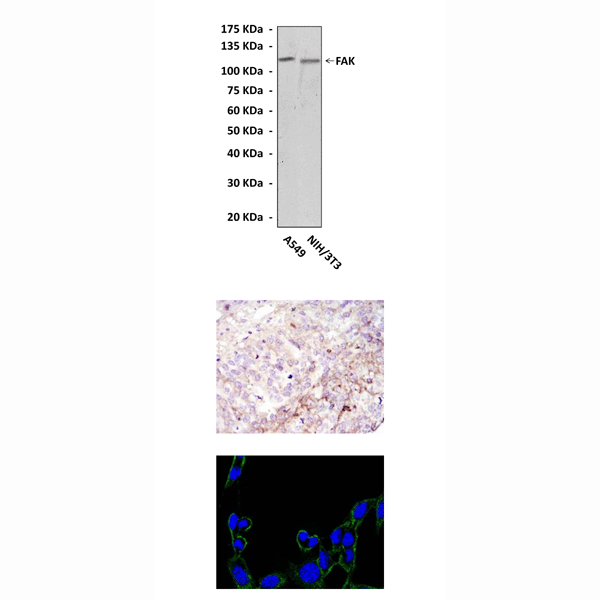Anti-FAK: Mouse FAK Antibody |
 |
BACKGROUND Focal adhesion kinase (FAK) is a protein tyrosine kinase, also known as PTK2, which is recruited to focal adhesions at an early stage, thereby mediating many downstream responses. Integrin stimulation induces FAK autophosphorylation at Tyr397, creating a binding site for the src homology 2 (SH2) domain of the Src-PTKs, src or fyn. The recruited, active Src-PTK phosphorylates several other tyrosine residues in FAK to affect both full FAK activation and the creation of phosphotyrosine binding sites for other signaling molecules, including the adaptor protein Grb2 and the p85-subunit of phosphatidylinositol-3-kinase (PI3 Kinase).1,2 The Src–PTK–FAK complex mediates the phosphorylation of certain FAK-associated proteins such as p130CAS and paxillin, and the recruitment of other signaling molecules (such as phosphotyrosine-dependent Crk binding to p130CAS and paxillin, and Nck binding to p130CAS), leading to formation of a multi-phospho-component signaling complex localized at focal adhesions.3 Given that the development of malignancy is often associated with perturbations in these processes, it is not surprising that FAK activity is altered in cancer cells. Mouse models have shown that FAK is involved in tumor formation and progression, and other studies show that FAK expression is increased in human tumors, making FAK a potentially important new therapeutic target.
REFERENCES
1. Schaller, M. D. et al: Proc Natl Acad Sci U S A. 89:5192, 1992.
2. Calalb, M. B. et al: Mol Cell Biol. 15:954, 1995.
3. Law, S.F. et al: Mol Cell Biol. 16:3327, 1996.
2. Calalb, M. B. et al: Mol Cell Biol. 15:954, 1995.
3. Law, S.F. et al: Mol Cell Biol. 16:3327, 1996.
Products are for research use only. They are not intended for human, animal, or diagnostic applications.
Параметры
Cat.No.: | CP10285 |
Antigen: | Raised against recombinant human FAK fragments expressed in E. coli. |
Isotype: | Mouse IgG1 |
Species & predicted species cross- reactivity ( ): | Human, Mouse, Rat |
Applications & Suggested starting dilutions:* | WB 1:1000 IP 1:50 IHC 1:50 - 1:200 ICC 1:50 - 1:200 FACS n/d |
Predicted Molecular Weight of protein: | 120 kDa |
Specificity/Sensitivity: | Detects endogenous FAK proteins without cross-reactivity with other family members. |
Storage: | Store at -20°C, 4°C for frequent use. Avoid repeated freeze-thaw cycles. |
*Optimal working dilutions must be determined by end user.
Документы
Информация представлена исключительно в ознакомительных целях и ни при каких условиях не является публичной офертой








